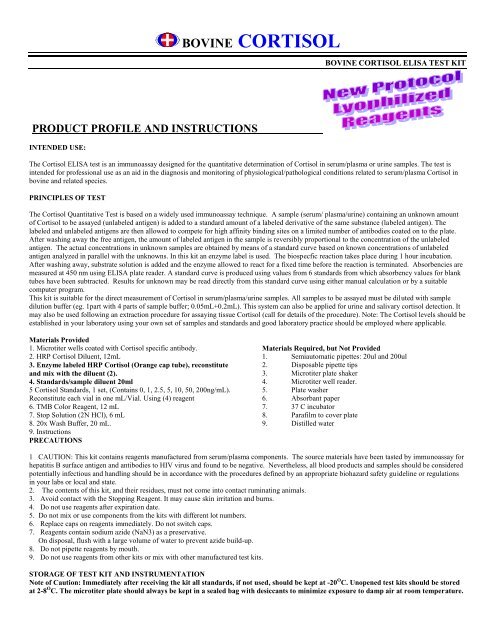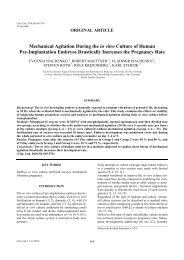BOVINE CORTISOL
BOVINE CORTISOL
BOVINE CORTISOL
Create successful ePaper yourself
Turn your PDF publications into a flip-book with our unique Google optimized e-Paper software.
<strong>BOVINE</strong> <strong>CORTISOL</strong><br />
<strong>BOVINE</strong> <strong>CORTISOL</strong> ELISA TEST KIT<br />
PRODUCT PROFILE AND INSTRUCTIONS<br />
INTENDED USE:<br />
The Cortisol ELISA test is an immunoassay designed for the quantitative determination of Cortisol in serum/plasma or urine samples. The test is<br />
intended for professional use as an aid in the diagnosis and monitoring of physiological/pathological conditions related to serum/plasma Cortisol in<br />
bovine and related species.<br />
PRINCIPLES OF TEST<br />
The Cortisol Quantitative Test is based on a widely used immunoassay technique. A sample (serum/ plasma/urine) containing an unknown amount<br />
of Cortisol to be assayed (unlabeled antigen) is added to a standard amount of a labeled derivative of the same substance (labeled antigen). The<br />
labeled and unlabeled antigens are then allowed to compete for high affinity binding sites on a limited number of antibodies coated on to the plate.<br />
After washing away the free antigen, the amount of labeled antigen in the sample is reversibly proportional to the concentration of the unlabeled<br />
antigen. The actual concentrations in unknown samples are obtained by means of a standard curve based on known concentrations of unlabeled<br />
antigen analyzed in parallel with the unknowns. In this kit an enzyme label is used. The biospecfic reaction takes place during 1 hour incubation.<br />
After washing away, substrate solution is added and the enzyme allowed to react for a fixed time before the reaction is terminated. Absorbencies are<br />
measured at 450 nm using ELISA plate reader. A standard curve is produced using values from 6 standards from which absorbency values for blank<br />
tubes have been subtracted. Results for unknown may be read directly from this standard curve using either manual calculation or by a suitable<br />
computer program.<br />
This kit is suitable for the direct measurement of Cortisol in serum/plasma/urine samples. All samples to be assayed must be diluted with sample<br />
dilution buffer (eg. 1part with 4 parts of sample buffer; 0.05mL+0.2mL). This system can also be applied for urine and salivary cortisol detection. It<br />
may also be used following an extraction procedure for assaying tissue Cortisol (call for details of the procedure). Note: The Cortisol levels should be<br />
established in your laboratory using your own set of samples and standards and good laboratory practice should be employed where applicable.<br />
Materials Provided<br />
1. Microtiter wells coated with Cortisol specific antibody.<br />
2. HRP Cortisol Diluent, 12mL<br />
3. Enzyme labeled HRP Cortisol (Orange cap tube), reconstitute<br />
and mix with the diluent (2).<br />
4. Standards/sample diluent 20ml<br />
5 Cortisol Standards, 1 set, (Contains 0, 1, 2.5, 5, 10, 50, 200ng/mL).<br />
Reconstitute each vial in one mL/Vial. Using (4) reagent<br />
6. TMB Color Reagent, 12 mL<br />
7. Stop Solution (2N HCl), 6 mL<br />
8. 20x Wash Buffer, 20 mL.<br />
9. Instructions<br />
PRECAUTIONS<br />
Materials Required, but Not Provided<br />
1. Semiautomatic pipettes: 20ul and 200ul<br />
2. Disposable pipette tips<br />
3. Microtiter plate shaker<br />
4. Microtiter well reader.<br />
5. Plate washer<br />
6. Absorbant paper<br />
7. 37 C incubator<br />
8. Parafilm to cover plate<br />
9. Distilled water<br />
1 CAUTION: This kit contains reagents manufactured from serum/plasma components. The source materials have been tasted by immunoassay for<br />
hepatitis B surface antigen and antibodies to HIV virus and found to be negative. Nevertheless, all blood products and samples should be considered<br />
potentially infectious and handling should be in accordance with the procedures defined by an appropriate biohazard safety guideline or regulations<br />
in your labs or local and state.<br />
2. The contents of this kit, and their residues, must not come into contact ruminating animals.<br />
3. Avoid contact with the Stopping Reagent. It may cause skin irritation and burns.<br />
4. Do not use reagents after expiration date.<br />
5. Do not mix or use components from the kits with different lot numbers.<br />
6. Replace caps on reagents immediately. Do not switch caps.<br />
7. Reagents contain sodium azide (NaN3) as a preservative.<br />
On disposal, flush with a large volume of water to prevent azide build-up.<br />
8. Do not pipette reagents by mouth.<br />
9. Do not use reagents from other kits or mix with other manufactured test kits.<br />
STORAGE OF TEST KIT AND INSTRUMENTATION<br />
Note of Caution: Immediately after receiving the kit all standards, if not used, should be kept at -20 O C. Unopened test kits should be stored<br />
at 2-8 O C. The microtiter plate should always be kept in a sealed bag with desiccants to minimize exposure to damp air at room temperature.
Opened test kits will remain stable until the expiration date shown, provided it is stored as described above. Do not leave any reagents at<br />
room temperature more than 3 hours.<br />
Instrument: A microtiter plate reader with a bandwidth of 10nm or less, with a bandwidth of 10nm or less and an optical density range of 0-3 OD or<br />
greater at a 450nm wavelength is acceptable for use in absorbency measurement.<br />
REAGENT PREPARATION<br />
1. All reagents should be brought to room temperature (25-28 O C) before use and all reconstitute tubes may take 30-40 minutes before completely<br />
dissolved.<br />
2. The Reference standards should reconstitute with one ml of standard diluent (and be kept frozen at -20C if not used immediately). You must make<br />
sure all the tube contents must be dissolved completely before use in the assy.<br />
3. Dilute wash buffer, desire amount with distilled water (1part with 19 parts). The buffer is stable for 1-3 months, if stored at 4-8C.<br />
4. Enzyme Conjugate dilution: The orange cap tube should be diluted with one of Enzyme diluent and mixed with the remaining 11 ml to make up12<br />
ml. If the requirement is only a small amount use 1:11 dilution at a time. You must make sure all the tube contents must be dissolved completely<br />
before use in the assy.<br />
5.Highly concentrated samples should be diluted wit sample diluent (eg. 1:5, or 1:10), to bring on to a readable range on the curve.<br />
ASSAY PROCEDURE<br />
1. Pipette 25ul of reconstituted standards<br />
2. Add 25ul of samples into appropriate wells marked for further identification.<br />
3. Add 100ul of Cortisol Enzyme Conjugate Solution (after reconstitution) to each well.<br />
4. Incubate for 1hours at 37C.<br />
5. Terminate the reaction and wash the plate 4-5 times with Wash Solution (250-300ul) per well. Invert<br />
plate, tap firmly against absorbent paper to remove any residual moisture,<br />
6. Add 100 ul of TMB color reagent into each well (including the blanks). Remember for pipetting order.<br />
7. Incubate the plate for 20 minutes without shaking.<br />
8. Stop reaction by adding 50ul of Stopping Solution (a drop) to each well in the same sequence that the<br />
Substrate Solution was added. Gently mix for 1-2 minutes.<br />
9. Read the absorbency at 450 nm with a microwell reader.<br />
NOTE: The substrate incubation should be carried out at room temperature (within the temperature range 25-28C). For temperature outside this<br />
range, the duration of the incubation should be adjusted by approximately 1 minute/1C.<br />
CALCULATION OF RESULTS<br />
1. Calculate the mean absorbance values (A) for each set of reference standards, controls, samples and<br />
blanks.<br />
2. Subtract the value for blanks from those for standards, control and unknown samples.<br />
3. Calculate the B/B% values by dividing each value by the value for the zero-standard.<br />
4. For the standards, plot a graph on semi-log graph paper with B/BO% values on the ordinate and the<br />
Cortisol concentrations (ng/mL) on the abscissa.<br />
5. Using the graph read off the Cortisol concentrations for the unknown samples.<br />
6. You may use any commercial assay soft-ware to analyze the data.<br />
EXPECTED VALUES AND SENSITIVITY<br />
It is recommended that each laboratory should establish values to reflect differences specific to experimental conditions. The minimum detectable<br />
concentration of Cortisol by this assay is estimated to be 1.0 ng/ml.<br />
Limitations & Warranty<br />
The present ELISA is designed for helping the scientist to analyze test samples only. There are no warranties, expressed, implied or otherwise<br />
indicated, which extend beyond this description of this product. Endocrine Technologies, Inc. is not liable for property or laboratory damage,<br />
personal injury, or test samples loss, or economic loss caused by this product. Warranty is limited to replacement of similar ELISA Kit damaged<br />
during shipment or leaking solutions within 30 days, with written explanation and return of the ELISA product. The analyst should establish the<br />
standard curve and a small number of samples before proceeding to analyze a large number of samples.<br />
REFERENCES<br />
1. BONDY PK. The adrenal cortex, in Randy PT, Rosenberg LE., Metabolic control and disease (8 ed) 1980,<br />
WB Sanders, Philadelphia, p1427-1499.<br />
2. Lambert AClinical Endocrinology 1974, Springer-Verlag New York, p299-305<br />
Methods in Radioimmuno assay p393-411.<br />
3. Spark R 1971, Simplified assessment of pituitary-adrenal reserve Annals of internal Med. 75 p75-717<br />
4. Thun R. et.al 1981. Twenty four hour secretory pattern of cortisol in the bull: Evidence pf episodic secretion and circadian rhythm.<br />
Endocrinology 109,p 2208-12<br />
5. Shutt DA and Fell LR. 1985. Comparison of total and free cortisol in bovine serum and milk or colostrum.<br />
J Dairy Sci 68 (7), p99-102<br />
Revised 04 2011<br />
<strong>BOVINE</strong> Cortisol ELISA Test Kit<br />
ENDOCRINE TECHNOLOGIES, INC. USA<br />
Product Profile and Instructions<br />
35325 Fircrest Street, Newark, CA 94560-1003 * Phone (800) 745-0843 * (510) 745-0844 * Fax (510) 745-0977<br />
www.endocrinetech.com



![[Mouse anti-OVA-IgE ELISA Kit] - Xceltis GmbH](https://img.yumpu.com/42983794/1/184x260/mouse-anti-ova-ige-elisa-kit-xceltis-gmbh.jpg?quality=85)
![[KLH (TDAR) Rat IgM ELISA KIT] - Xceltis GmbH](https://img.yumpu.com/38115440/1/184x260/klh-tdar-rat-igm-elisa-kit-xceltis-gmbh.jpg?quality=85)
